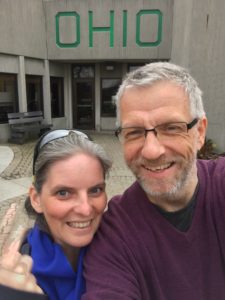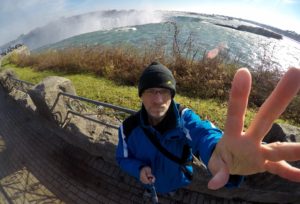It’s Thanksgiving in the US today. Over here it’s probably THE biggest holiday each year, and a real national event. Since the eighties, the US President has pardoned turkeys and made live speeches on TV for many decades. Thanksgiving is an event that’s bigger than Christmas in the US. It’s THAT big.
Quick bit of trivia: Thanksgiving is also celebrated in Canada, but the event falls on the second Monday in October. Americans on the other hand celebrate Thanksgiving on the fourth Thursday in November (hence the actual date changes every year). I remember the German Erntedankfest, a similar event around a similar time, but it’s of much lesser importance.
For me it’s the first time I’m actually celebrating the event “American Style” at the home of our friends Jayshree and Mukesh in Westerville, Ohio. We have a lot of catching up to do, we had been meaning to drop by for a visit for years, but when I got ill we had to postpone those plans. This year it finally happened – and what a lovely celebrational trip we’re having indeed.
Not only is this meeting long overdue, it’s also the first time I’m able to travel since the whole cancer ordeal started. I feel like I’ve fully recovered, and long travel times in cars and planes are a great test for me to see how well my body copes with these situations after so many surgeries. So far, it’s going great: digestion is playing ball, overall fitness holds up well, body weight is stable (at around 204 pounds, give or take two), and apart from more frequent urination breaks, I can’t tell a difference.
On top of all that, I’ve had my other two wisdom teeth pulled only two weeks ago, but even that has healed (without the Amoxicillin antibiotics I was supposed to take). I’ve heard this before: I’m a healer, or rather, my body has the amazing ability to heal. All our bodies do that. It’s easy to forget when you’re well.
And that’s the inspiration behind this post: we forget all too easily. I’m trying to make a big effort to capture things around me, both as text, as images, and as videos. Sometimes it’s just moments, sometimes it’s technical knowledge, but the most important things to put down on paper are those subtle intuitions we experience, the non-verbal “out of the blue” thoughts that present themselves to us. I find them so very fleeting, and I think they deserve to be enjoyed and remembered.
I’ve had several of those moments recently, and I thought I’d share them with you. If you’ve read my book, you’ll know that I have an issue with food. It’s a bit like being an alcoholic. An easting disorder never really goes away, you’ll have to find a way to manage it. Although I don’t have any technical dietary restrictions, the last thing I want is to overload my body with too much food due to a mental inability to gauge how much is enough.
So here’s what happened: Thanksgiving and our whole trip is about many things, one of which is food. We have food all the time, and it’s exciting to try out new things like Giordano’s Chicago style deep pan pizza, Fish & Chips at that Indian Reservation in New York or authentic German sausages at Schmidt’s in Columbus. I’m honoured and excited that I can be part of those things again. Those “normal” little things.
My intuitive (“normal”) behaviour however is to eat too much, and probably also to drink too much. Not to an excessive degree mind you, but I guess there’s a sliding scale of what “too much” actually means to each and everyone of us. It’s like “normal”: it’s a very individual term, and “normal” may mean something very different to me than it may mean to you. I don’t like using either term very much for that reason.
In my world, “too much” would be two or three slices of deep-pan pizza, a whole portion of fish and chips (plus sides and desert), or two to three plates of whatever a buffet has to offer. My intuitive behaviour would be to eat without checking in with myself as to how my body felt. Even if I did, I just don’t get a lot of feedback from my body – until it’s too late and too much food is ingested.
I can understand why a proper feedback mechanism is difficult: by the time food hits our stomach, it has not been digested, so there’s no way to detect the actual effect of the calories in our bloodstream. We need to give it about half an hour or longer to “feel” things like raised blood sugar levels. It’s easy to keep feeling “hungry” for longer than we actually are.
And that’s what I keep realising on more and more occasions: rather than waiting for the feeling of “my food is kicking in”, I stop eating before that happens. And when I honour this feeling, and trust that the smaller amount of physical food will provide me with energy for hours to come, I’m noticing the enormous beneficial effects later: the absence of heartburn, the feeling of being full of food, yet being comfortable at the same time, the absence of the “stone in your stomach”.
It’s like my outdated notion of what it feels like to be “full” is being updated with “feeling full 2.0”. What I’m feeling there is a different sensation altogether. Slowly and gradually I’m beginning to realise what other people have been regarding as feeling full for many years. What I’ve been regarding as full was really a feeling of “I’ve eaten too much already”.
My wife Julia is a great example of someone who never overeats. She has a great relationship with her body and only very rarely if ever overeats, no matter how amazing the food in front of her is. I find that very inspirational.
It’s somewhat of a breakthrough for me to experience this more and more, that’s why I’m making a note of it here. To remind me of this fact, and to share my discovery with y’all.
The term to “honour your body” is something of a catchphrase my phenomenal nutritionist Julie Rothenberg uses regularly. Her philosophy is that there is no “bad food”, and it’s all about balance and quantities: if you feel like pizza, eat pizza. If you feel like fries, eat fries. The trick is to NOT eat a whole pizza, or NOT eat the whole 2 pounds of fries in the extra large bag in front of you. The challenge is to NOT feel the need to finish the oversized portions we’re served in a restaurant, or be blinded by the notion that you could indeed eat the whole all-you-can-eat buffet.
I’m a techie, so for me one of the interesting aspects of any complex process is “how does it work”. It’s all fair and square having discovered something, but more importantly is to bring across is how to replicate something the next time a similar situation presents itself. Like that forthcoming Thanksgiving Turkey Dinner. How to NOT fall into the same trap as before, and how NOT to overeat.
In the interest of full disclosure, this is a long and intricate process. I’ve not just woken up two days ago and I knew how it worked, preceded by a lifetime of regularly overeating. It wasn’t like that at all. I think for me it started during my many hospital vacations: their portion sizes were tiny compared to what I was used to. This was followed by an extended period of not eating at all during the TPN months, for the better part of a whole year. Following that, when I started eating again, I noticed the uncomfortable presence of food in my body – and to tell you the truth, I really didn’t like that!
But humans have to eat, and soon I got used to this fact again and didn’t notice it as uncomfortable anymore. During that time I made sure to document what I was eating. I felt it necessary to experiment with various types of food and check in with myself regularly to see what nutrition had what effect on my wellbeing. I used My Fitness Pal for that, a convenient app that lets you scan the barcode of many products and jot down what you had for breakfast, lunch, dinner and in between. By the end of the day, you know how many calories you’ve eaten, how your nutritional balance between carbs, protein and fat was – and most importantly – how many calories you’ve had.
I could monitor if I was missing important building blocks in my diet, if I had eaten too much, if I hadn’t eaten enough, to see if I was on target or not. I don’t use that app anymore, but for many months, I was meticulous of tracking what I was putting in me. This helped reset my relationship with food and was a fabulous aid in building a completely new relationship with food.
As you can imagine, the more you live without an app like that, the old “die hard” habits are bound to creep in. That’s when I’ve noticed a slight feeling of bodily discomfort returning in connection with ingesting food. I realised my body wasn’t happy, and I examined my behaviour. My portion sizes had gradually increased again.
I took this as a queue to try and experiment with what, when and how much I was eating (without using an app this time). To my own astonishment I found out that – just like Julie suggests in her many inspiring posts on Instagram – I could eat what I wanted without feeling discomfort afterwards. All I had to do was tune in to a very faint new message that my body was sending when a certain amount of food had hit my stomach. This amount varied depending on what I was doing on any given day and the exercise I did.
The interesting thing to me was that this message was NOT what I had previously associated with the feeling of “being full”. It was a much more subtle notion that I had not connected with food yet. It came from a different area, or on a different frequency, or in a different language so to speak. Hard to describe, yet very important to understand the process.
Going with that message, and making a conscious effort to honour that feeling, the side effects of overeating do not present themselves. I found that very exciting indeed!
Today I try to remember this feeling every time I eat. I don’t always succeed, or there are times when I forget, but as with so many things: practice makes perfect. Try it out with your next meal, see if you can spot that message.
What strikes me time and time again is that there’s more to ingesting food than meets the eye. It’s not as simple as interpreting messages. The difficult part, especially for those of us with eating disorders, is to find those messages in the first place. The absence of those messages makes acting on them at the right time super difficult, or downright impossible for many of us.
Julie really gets this, and she does her best to teach us all how to do it. I’m on Instagram just to read those inspiring and helpful tips and tricks she posts. So there you go, that’s my inspirational tip for this Thanksgiving: see if you can find that message. See if Julie’s posts are as helpful to you as they are to me. Experience what it feels like to honour your body.
And be grateful. Not just today, but every day. I know I have a ton of things to be grateful for. I’m alive! I’m well! I’m cured! I can spend time with my friends across the country. And I’m aware of all these things, so aware in fact that I can share my observations with you.
Happy Thanksgiving everybody 🙂
PS: To see what else I’ve been up to this November, checkout my November Playlist on YouTube. It has many short snippets of inspirational ramblings, as well as some stunning footage of the Niagara Falls I’ve taken. The month isn’t over yet, so there’s more to be added to that playlist!



